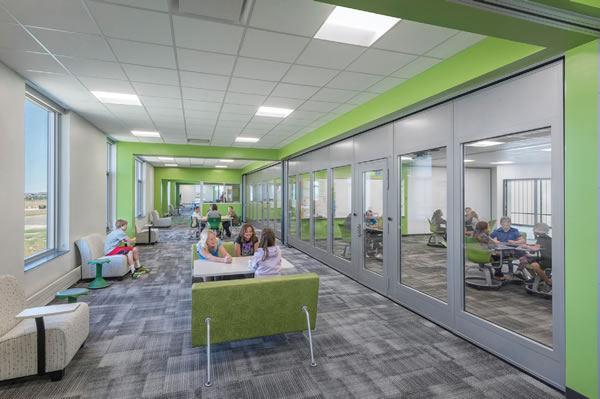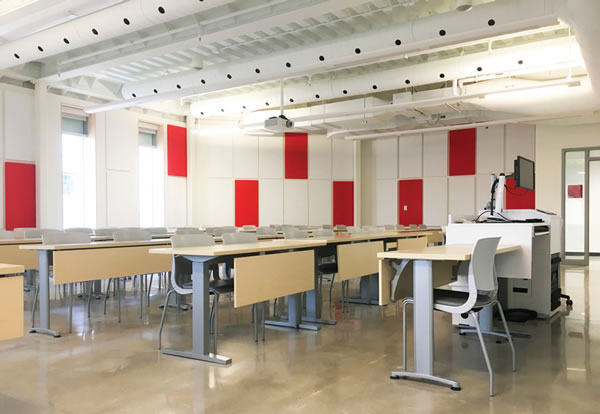The Noisy Classroom
How walls, ceilings and everything in between impact the way children hear.
- By Sarat Pratapchandran
- 09/01/19

© CONNOR STEINKAMP / PHOTO COURTESY OF DLR GROUP
Millions of children leave school “having simply
not heard much of their education,” according to global
sound and communications expert Julian Treasure.
“We are watering a garden and missing the flowers,” he said.
Hearing impairment affects one in six students once you add
those with ear infections and other temporary illnesses. And, the
built environment, especially walls, ceilings and everything in
between impact the way children hear.
According to Regina Zappi, Au.D., CC-A, Associate Director,
Audiology Professional Practices at the American Speech-Language-Hearing Association (ASHA), “hearing and understanding
are important parts of the learning process.”
The Impact on Learning
Poor classroom acoustics impact how a student understands
speech, reads and spells, behaves in the classroom and concentrates
in class.
A 2004 study led by Donald Jamieson at the University of
Western Ontario found that “the youngest children in the school
system, whose classrooms also tend to be among the noisiest, are the most susceptible to the effects of noise.”
Their auditory abilities are still developing.
“Every six feet, the sound of a teacher’s
voice is going to decrease by three decibels,”
said James Wright, western territory
manager for acoustic panel manufacturer
Primacoustic. By the time the teacher’s
words reach children in the back row, it’s
down significantly in volume.
The ambient noise from the built environment,
including HVAC noise, the basic
structural noise of the building, traffic,
etc., also impact the way children hear.
When children start shifting seats and
moving their desks, this competes with the
teacher’s voice.
Architects and acoustic experts cite
reverberation, commonly known as reverb,
as an important aspect of sound that impacts
learners. “Reverberation is the persistence
of sound and reverberation time is
measured in decimals of seconds. This is
the time it takes for a sound to decay 60dB
and varies with frequency,” said Jason
Lembke, AIA, principal at DLR Group.
According to Lembke, U.S. and European
standards for reverberation times
(RT) in classrooms differ, and “generally,
a reverberation time range between 0.4
seconds and 0.8 seconds is desirable for
schools.”
However, classrooms with an RT of over
one second are not conducive for an ideal
learning space.
“The ideal is 0.5 seconds,” sound and
communications expert Treasure said.
Construction Materials
In the built environment, “absorptive
materials do not isolate sound well, while
sound isolating materials do not absorb
sound well,” said Lembke.
Today, gypsum wallboard (gyp) and
concrete masonry units (CMU) are primarily
used in classroom wall construction.
Ceilings can be exposed to the building’s
structure, suspended tile products (pressed
fibers, gypsum, fiberglass) or even wood.
According to Lembke, spaces needing
an exposed structure should add acoustic
materials (boards, sprays, etc.) to improve
the performance of the space. The use of
resilient flooring (VCT, LVT, ceramic tile,
rubber, etc.) or softer carpet products is
recommended. They all differ in costs,
lifecycle and performance and should be
analyzed to find out how they impact the
learning environment.
The classroom is filled with hard
surfaces. They reflect sound reaching the
student’s ears at delayed times.
“Sound travels at about one foot per
millisecond. So, if you’ve got a 30 foot long
classroom, that’s a 30 millisecond delay,”
said Wright. “This makes it difficult for the
brain to process sound coming at you four
or five times at four or five different timing
intervals.”
School audiovisual suppliers or administration
officials will recommend voice
assist technologies to address the problem.
“There is no real benefit to the amplification
systems unless you do something to
the room to actually address the acoustics
issues first.”
Wright advocates using acoustic treatment
in classrooms, as it will “bring the room
noise level down to an area where a teacher
can use their natural speaking voice.
Distractions
Bare walls and high ceilings contribute
to poor listening and we live in an
age where there is a premium on careful
listening. According to Treasure, screens
and keyboards dominate our communication
and technology demands our constant
attention.
“Children are simply not developing
the habit of paying total attention to another
person speaking,” he adds.
Poor acoustics in the built environment
can impact teachers as well. “Average
noise levels in German schools have been
measured at 65 dB, which may not damage hearing but does increase the risk of heart
attack with long exposure — so teachers
may be shortening their lives by working in
such environments,” said Treasure.
Today, one in three of a teacher’s sick
days are a direct result of voice burnout
as they have to talk too loudly to reach
students. “We talk at 60 decibels, give or
take, as our basis for speaking. If your basic
room volume, with ambient noise and all, is
already at 60dB, all of a sudden a teacher is
using a raised voice for four, five, six hours a
day just to be heard over the natural sounds
of the room,” added Wright.
Design Solutions
However, innovative design solutions
like “the operability and flexibility in wall
positioning can dramatically impact the
acoustic performance of a space,” said DLR
Group’s Lembke.
An example is the Dickinson Middle
School in Dickinson, North Dakota.
With high mobility rates — 40 percent of
students move in or out during the school
year — teaming and community-building
were a priority.
“Three of the four walls in the classrooms
can be shifted or opened and [have]
been designed for maximum agility. Classrooms
can be merged, shifted and opened
to adjacent areas,” Lembke said.
Groups from four to fifty are supported,
and conference space can be created
just by moving walls and accessed from
hallways without acoustically impacting
the classrooms.
This built solution allows teachers to
collaborate effectively and for students to
seize opportunities academically, as well as
personally with their peers.

PHOTO COURTESY OF PRIMACOUSTIC
Hear, Hear. The use of acoustic panels can dramatically change the user experience. An example is
the renovation of the auditorium at Aspen Academy in Denver where Primacoustic was involved. The
company’s wall and ceiling panels helped resolve reverberation and sound bleed issues inside the
auditorium.
Materials Solutions
Another solution, Armstrong’s Total
Acoustics ceilings, “do two things at once:
They absorb sound instead of reflecting it
back, and they also block unwanted noise
from adjacent spaces, making classrooms
quieter and more comfortable,” said
Treasure.
Meanwhile, the use of acoustic panels
can dramatically change the user experience,
according to Wright. An example is
the renovation of the auditorium at Aspen
Academy in Denver where Primacoustic
was involved. The company’s wall and ceiling
panels helped resolve reverberation and
sound bleed issues inside the auditorium.
“School administrators were so happy
with the results that they have now commissioned
an acoustic treatment project
for the cafeteria, which also has similar
reverberation and intelligibility issues,”
Wright said.
Another example is Simon Fraser
University in Vancouver. A decade ago,
the school decided to remove all padded
seating and carpeting from their concrete
lecture halls. Soon they realized that
students could not learn in those rooms
because they became echo chambers.
“By covering 20 percent to 25 percent of
the wall surface area with acoustic panels,
the lecture halls became very balanced
and very desirable again to use as lecture
centers,” Wright added.
According to DLR Group’s Lembke,
their integrated design practice employs
higher STC (sound transmission class)
ratings “in our demising walls between
classrooms and extend those walls to
structure to limit noise transfer.”
They also recommend LED lights to
eliminate noisy ballasts; fresh and conditionedair is distributed through ducted
and dampened systems; and the air speedis sufficiently slow enough not to impact
conversation or quiet study. Furniture with“soft” feet allows for ease of movement
without nuisance noise or vibration.
Yet, the cost of improving the acoustical
environment remains a challenge for school districts where sometimes the
priority is investing money in athleticfields compared to students listening in the
classroom.
“We need listening now more than ever
because conscious listening is the doorway
to understanding,” said Treasure.
This article originally appeared in the School Planning & Management September 2019 issue of Spaces4Learning.